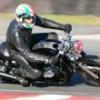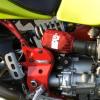-
Posts
451 -
Joined
-
Last visited
-
Days Won
6
Weegie last won the day on May 10
Weegie had the most liked content!
About Weegie
- Currently Viewing Topic: V11 Daytona project
- Birthday July 11
Profile Information
-
Location
Scotland
-
My bike(s)
98 Magni Australia, 92 Magni Sfida 1000, 99 Magni Sfida 1100, 2017 BMW R9T Racer
Recent Profile Visitors
3,784 profile views
Weegie's Achievements

Forum-aholic (3/5)
624
Reputation
-
Had the same problem with the rod when I installed a RAM into the LM 1000, for exactly the reasons @Lucky Phil stated. Not the most difficult problem I've ever had and easy to rectify.
- 39 replies
-
- 1
-

-
That's what I was going to suggest Extend aditional pos connections down to the starter
-
I'd definately replace the HT leads caps and plugs (if not new), then go from there. First I'd heard about the crank position sensor failing causing intermittent and bad running, another school day I guess. As I recall the CO enrichment pot near the ECU is only in play up to around 3k RPM. Cannot remember where I came across the info, but also seen it reported that it's in play throughout the rev range.........but I believe that's wrong.
-
Just wondering if the oil level was really low and you cranked into a turn, you uncovered or partially uncovered the pump suction, leading to a momentary loss of oil pressure. If that was the case then in all probability it would recover pressure once upright or close to upright, explaining the event. If the oil was really low then the Roper Plate would probably do little to prevent this Of course I'd go through the preventitive actions already mentioned by others and me, just to entirely rule out other causes. Good Luck with the checks, be interesting to know what you find. John
-
Hi Dave Not sure of the sequence of events, the bike stuttered and died after sitting some time, after you had lunch, so it was cold, or slightly warm but not hot? When did the low pressure light illuminate after starting? Did it stay on after you applied some throttle/revs then go out and only flickered on for a second or two? Just my opinion, the flicker of the light could be nothing, the switch/connections needing attention or genuine low pressure and investigation into the mechanicals. Many others have gone into the probable causes. I'd first check oil level, then get a gauge onto it, remove the plugs (to lessen the strain on the bearings and increase crank speed) and crank it over. If it's cold the oil pressure should register quickly, within a few seconds and spin up to at least 40, I usually see 60 on the Sporti (more or less same bottom end) I'd be concerend about engine mechanical integrity first, sputtering and faulty pressure swtich/electrics would concern me less, although obviously needing to be looked into later. John
-
Been a few years but I've got his email as will.creedon@gmail.com Hope that helps
- 1 reply
-
- 1
-

-
Of course I agree with Phil Not much to add on the Sport 1100 and the LM 1000 2 v/v bikes I run 15W/50 oil pressure is stable, even when the bikes get pretty toasty. The Sporti can easily reach 120C (around 250F) sump temp in traffic. When it starts to exceed that the bike quickly becomes unrideable, so oil pressure is academic. In clear air Sporti oil temp is around 80C (176F) although will rise quickly to 100C (212F) The C kit HiCam is a different kettle of fish altogether, run a 10/60 in it, in clear air around 100C (212F), in town I've seen 140C, again totally unrideable by then. Still got idle pressure but dammed little. Of course all the oils are group 4 full synth (so I've been told) Purely anectodal but the only bike I've needed a 10/60 on is the C kit HiCam and that's because of the C kit cams. Earlier HiCams (Daytona and Centauro) without the crazy cams aren't subject to the same heating issues. No C kit cams went into US bikes.
-
I have a Magni Sfida 1100, essentially a Sporti running the legacy version of MyECU. The installation and map was made by the previous owner of the bike and I haven't messed with it, I've never felt the need. About the only thing I've did is reset the TPS a few times. I'm not fussed on the finer points of how the engine runs, it accelerates pretty well and has more than enough power for my needs Probably a bit on the rich side, it has K&N pods, again it came to me this way. Mine can on ocassion, be a little reluctant to fire up cold, but not to the point I feel the need to mess with it. Just saying you're not alone with this setup
-

The Most Beautiful Cafe Racer Yet?
Weegie replied to Joe's topic in Special place for banter and conversation
I really like the styling and yet to come across a negative review of the R12S. If looking for retro/hipster/cafe machine with nods to an earlier era but updated then surely it would be worth consdering (if you could afford the hefty price tag) Only criticisms were price and the throttle could be snatchy in Dynamic mode Owning an older sibling to the R12S, an R9T Racer, perhaps the boy's from Bavaria listened to all the comments about the Racer. The biggest flaw was the bars set into the triple clamp coupled to a long tank. I'm 5' 7" and it's a huge stretch, arms locked out most of the time. Many owners installed Helibars, I eventually opted for raised clip ons, but even with these the position is still pretty extreme. -
Great to hear from you Roy Hope you stick around a bit more and all is well I took the liberty of hosting some of your electrical sketches on Dropbox for other members to copy as they need. I hope that's Ok with the diagrams are a fantastic resource, let me know. All the Best John
-
Just to add that Relay 5 has a very hard life powering all that equipment If I were a betting man it's where I'd put my money on which relay will fail first But as @GuzziMoto logical first step is to check for voltage at the pump
-
Apologies @Steve Swan if you purchased the pump from MG Cycle then I'd ASS-ume it was Ok as they are pretty good and know Guzzis backwards. If the bike runs well, then it's probabaly fine. I'm too anal when it comes to that sort of thing. As I'm sure you're aware if a pump drastically didn't match the OEM ratings it could stress other components in this case the pressure control/relief valve, or even overwhelm it, in which case fuel pressure would rise, with all sorts of problems
-
To add to @gstallons post, I did wonder if you'd matched the flow and pressure ratings of the OEM pump when replacing with an aftermarket. I don't know the Le Mans, but I did have to replace the Bosch pump on my Sporti engined bike. The Bosch pumps for that bike are now readly available but at the time they were as plentiful as Hen's teeth I eventually ended up replacing it with a Pierburg pump, which closely matched the Bosch rating at considerable expense
-
After reading through this thread, I wonder if the bits I've put onto the Sfida have only resulted in detracting from the beauty of the original design. In many ways its become a bitsa but the whole topic is subjective. When rebuilding it back up I couldn't help but notice many of the components were less than ideal and I installed after market parts. Also spent a lot of time trying to undo bodges and there were quite a few. There wasn't any grand plan, but I'm very happy with it as it is now. Thank you for all the "likes"
-
Sounds like what Guzzi owners refer to as Startus Innterus @docc beat me to the punch, regarding Roy's diagram Regarding the Bosch relay, according to the spec I found its rated at 20A I'm not sure about the relay layout on the V11 but the Power Relay operating fuel pump, injectors and coil has to feed a large load If it was me unless there is something wrong with the Chinese one I'd leave it, as it's a larger rating (if it's to be believed of course)



